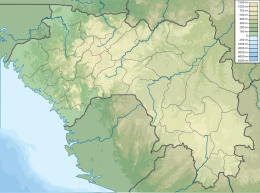Los Islands
| Native name: Îles de Los | |
|---|---|
 |
|
| Geography | |
| Location | Atlantic Ocean |
| Coordinates | 16°36′S 11°41′E / 16.600°S 11.683°ECoordinates: 16°36′S 11°41′E / 16.600°S 11.683°E |
| Archipelago | Îles de Los |
| Total islands | 8 |
| Major islands | Tamara (Fortoba), Kassa and Roume |
| Area | 80 km2 (31 sq mi) |
| Length | 10 km (6 mi) |
| Width | 7 km (4.3 mi) |
| Highest elevation | 47 m (154 ft) |
| Highest point | Sommet Lacroix |
| Administration | |
|
Guinea
|
|
Îles de Los (English: Los Islands) are an island group lying off Conakry in Guinea. Their name is derived from the Portuguese: Ilhas dos Ídolos, "Island of the Idols". They are located about 2 km off the headland limiting the southern side of Sangareya Bay.
The islands are best known for their beaches and forested interiors and are popular with tourists. Ferries sail to the Los from Conakry.
There are three main islands: Tamara (Fortoba), Kassa and Roume. Île de Corail, Île Blanche, Île Cabris, Île Poulet, Îlot Cabri and Îlot de la Bouteille are smaller islands and islets located in the southern half.
Tamara is home to the Île Tamara lighthouse. There was also a prison built on Tamara.
This island has also previously been known as Crawford Island, when under British rule. Roume is said to have inspired the novel Treasure Island.
This island has also previously been known as Factory Island. The name is derived from the Portuguese word "casa".
The islands been inhabited for a long time and rose to prominence for their role in slave trade. In 1755 Miles Barber of the African Company of Liverpool established a factory there employing workers skilled in ship repair as well as pilots for the local rivers. This led to Kassa being known as "Factory Island". English language sources in the 18th century gave various corrupted names for the islands including "Isles of Loss", "the Edlesses", "The Idols", or "Las Idolas".
In 1812 Samuel Samo, a Dutch slave trade was seized by the British there and taken to Freetown, Sierra Leone where he appeared before the vice admiralty court. He was the first person tried under the British Slave Trade Felony Act 1811.
...
Wikipedia

